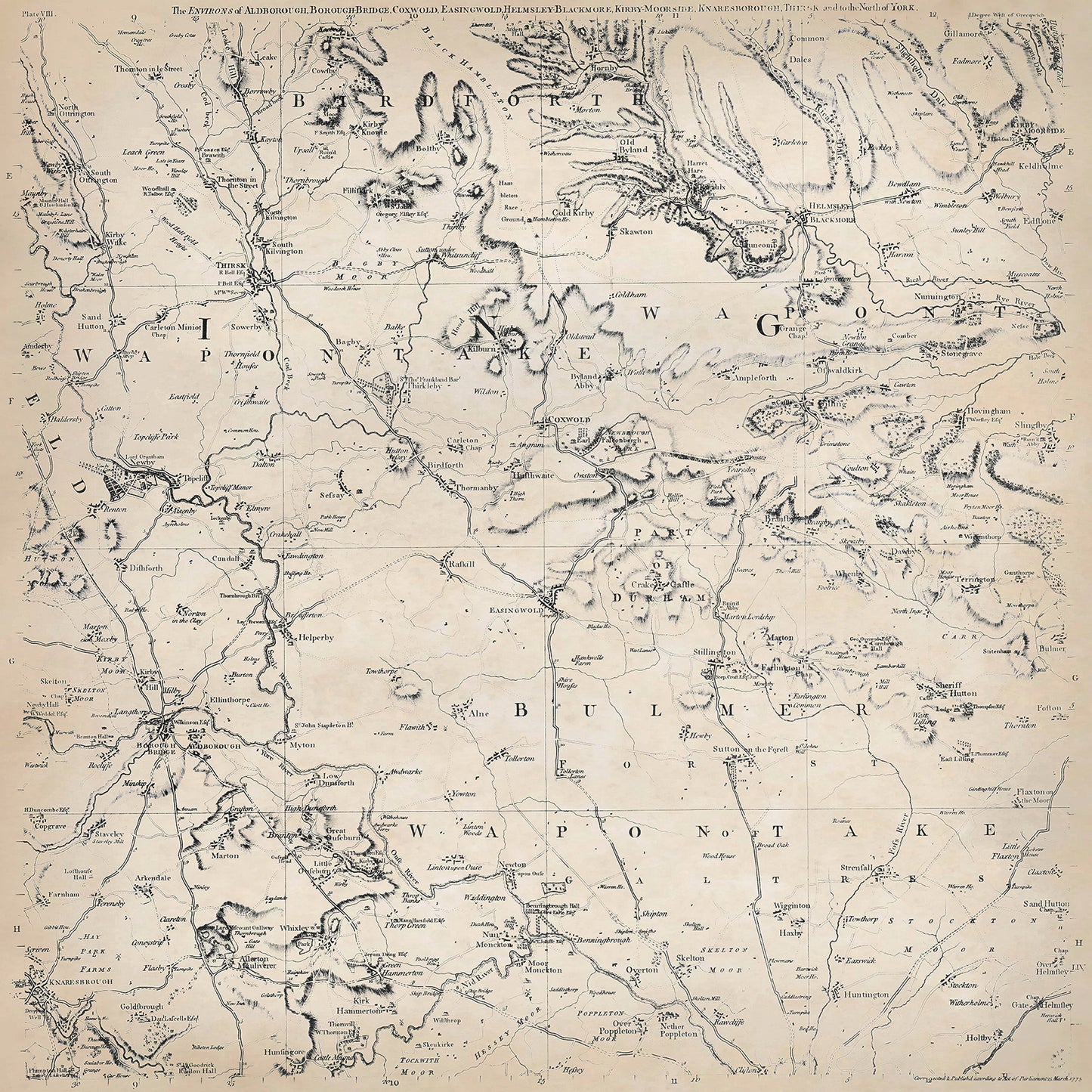Elite Wall Decor
Yorkshire in 1771 sheet 2-3 - shows the Aldborough, Borough Bridge, Coxwold, Easingwold, Helmsley Blackmore, Kirby Moorside, Knaresborough, Thirsk area
Yorkshire in 1771 sheet 2-3 - shows the Aldborough, Borough Bridge, Coxwold, Easingwold, Helmsley Blackmore, Kirby Moorside, Knaresborough, Thirsk area
Couldn't load pickup availability
Downloading this large file to phones or tablets is not recommended
This digital download is a high-quality 300dpi JPG image of one sheet from Thomas Jefferys "The County of York Survey'd" published in 1771. The image is crisp, clear and easy to read. It measures 60 x 60 cm, or 7087 x 7087 pixels but can be cropped or resized with the appropriate software. Download now to print whole or in part at home, or simply view it in close up on your device using image software such as Adobe Photoshop, Gimp, Windows Photo, or similar.
Aldborough:
Aldborough is a historic village located in North Yorkshire, known for its Roman heritage and archaeological sites.
Agriculture was the primary occupation in Aldborough and its surrounding areas.
Aldborough had limited industrial activity during this period. Cottage industries, such as spinning wool and producing textiles, were prevalent. The village also had a few craftsmen, including blacksmiths and carpenters.
Aldborough Roman Site, an archaeological site showcasing the remains of a Roman town, was a notable attraction. Visitors could explore the ancient ruins, including the remains of a forum and a theater.
Boroughbridge:
Boroughbridge is a small town situated on the River Ure in North Yorkshire, known for its historic bridge and market.
Agriculture played a significant role in Boroughbridge's economy during the late 18th century. Farmers cultivated crops such as barley, oats, and hay. The town's rural surroundings supported sheep farming as well.
Boroughbridge had limited industrial activity, with some residents engaged in spinning wool and producing textiles. The town's market provided employment opportunities for traders, merchants, and craftsmen.
Boroughbridge was known for its ancient bridge, which crossed the River Ure. The bridge, with its distinctive architecture and historical significance.
Coxwold:
Coxwold is a picturesque village located in North Yorkshire, known for its historic buildings and association with Laurence Sterne, the author of "Tristram Shandy."
Agriculture was the main occupation in Coxwold and its surroundings. Farmers cultivated crops such as wheat, barley, oats, and vegetables. Sheep farming was also prevalent.
St. Michael's Church, a historic church dating back to the 15th century, was a notable landmark in Coxwold. The church's architectural features and connections to Laurence Sterne's writings made it a point of interest for visitors.
Easingwold:
Easingwold is a market town located in North Yorkshire, known for its Georgian architecture and bustling market.
Agriculture was the primary occupation in Easingwold and its surrounding areas.
Easingwold had limited industrial activity during this period.
Helmsley:
Helmsley is a picturesque market town located in the Ryedale district of North Yorkshire, known for its medieval castle and charming streets.
Agriculture played a significant role in Helmsley's economy during the late 18th century.
Helmsley had limited industrial activity during this period.
Helmsley Castle, a medieval fortress with well-preserved ruins, was a major attraction. The town's streets, lined with historic buildings and traditional shops, created a charming ambiance for visitors.
Blackmore:
Blackmore is a small village located in the Howardian Hills in North Yorkshire. Agriculture was the primary occupation in Blackmore and its surroundings. Blackmore had limited industrial activity during the late 18th century.
Kirbymoorside:
Kirbymoorside is a small market town located in the Ryedale district of North Yorkshire. It has a rich history and a charming rural setting. Agriculture was the primary occupation in Kirbymoorside and its surrounding areas. Kirbymoorside had limited industrial activity during the late 18th century. The town's historic buildings, such as All Saints' Church, a medieval parish church, and the Black Swan Inn, added to its charm.
Knaresborough:
Knaresborough is a historic market and spa town located on the River Nidd in North Yorkshire. It is known for its picturesque setting and attractions. Agriculture played a significant role in Knaresborough's economy during the late 18th century.
Knaresborough had various industries during this period. The town was known for its linen and cotton weaving industry, with weavers producing textiles. Other industries included tanning and leatherworking, as well as brewing. Traders and merchants operated in the town's market, offering goods for sale.
Knaresborough Castle, a ruined medieval fortress overlooking the River Nidd, was a major attraction. The town's picturesque setting, including the famous Knaresborough Viaduct and Mother Shipton's Cave, drew visitors.
Thirsk:
Thirsk is a market town located in the Hambleton district of North Yorkshire. It is known for its historic charm and connections to author James Herriot.
Agriculture was the main occupation in Thirsk and its environs.
Thirsk had limited industrial activity during the late 18th century.
The town's historic buildings, such as Thirsk Hall and St. Mary's Church, are also points of interest.

